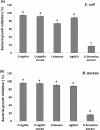Synthesis and biological characterization of silver nanoparticles derived from the cyanobacterium Oscillatoria limnetica
- PMID: 31506473
- PMCID: PMC6736842
- DOI: 10.1038/s41598-019-49444-y
Synthesis and biological characterization of silver nanoparticles derived from the cyanobacterium Oscillatoria limnetica
Abstract
Using aqueous cyanobacterial extracts in the synthesis of silver nanoparticle is looked as green, ecofriendly, low priced biotechnology that gives advancement over both chemical and physical methods. In the current study, an aqueous extract of Oscillatoria limnetica fresh biomass was used for the green synthesis of Ag-NPs, since O. limnetica extract plays a dual part in both reducing and stabilizing Oscillatoria-silver nanoparticles (O-AgNPs). The UV-Visible absorption spectrum, Fourier transforms infrared (FT-IR), transmission electron microscopy (TEM) and scanning electron microscope (SEM) were achieved for confirming and characterizing the biosynthesized O-AgNPs. TEM images detected the quasi-spherical Ag-NPs shape with diverse size ranged within 3.30-17.97 nm. FT-IR analysis demonstrated the presence of free amino groups in addition to sulfur containing amino acid derivatives acting as stabilizing agents as well as the presence of either sulfur or phosphorus functional groups which possibly attaches silver. In this study, synthesized Ag-NPs exhibited strong antibacterial activity against multidrug-resistant bacteria (Escherichia coli and Bacillus cereus) as well as cytotoxic effects against both human breast (MCF-7) cell line giving IC50 (6.147 µg/ml) and human colon cancer (HCT-116) cell line giving IC50 (5.369 µg/ml). Hemolytic activity of Ag-NPs was investigated and confirmed as being non- toxic to human RBCs in low concentrations.
Conflict of interest statement
The authors declare no competing interests.
Figures











References
-
- Bilal M, Rasheed T, Iqbal HMN, Hu H, Zhang X. Silver nanoparticles: Biosynthesis and antimicrobial potentialities. Int. J. Pharmacol. 2017;13:832–845. doi: 10.3923/ijp.2017.832.845. - DOI
-
- Sharma A, et al. Algae as crucial organisms in advancing nanotechnology: a systematic review. J Appl Phycol. 2015;28:1759–1774. doi: 10.1007/s10811-015-0715-1. - DOI
-
- Rittner MN, Abraham T. Nanostructured materials: An overview and commercial analysis. JOM. 1998;50:37–38. doi: 10.1007/s11837-998-0065-4. - DOI
MeSH terms
Substances
LinkOut - more resources
Full Text Sources

